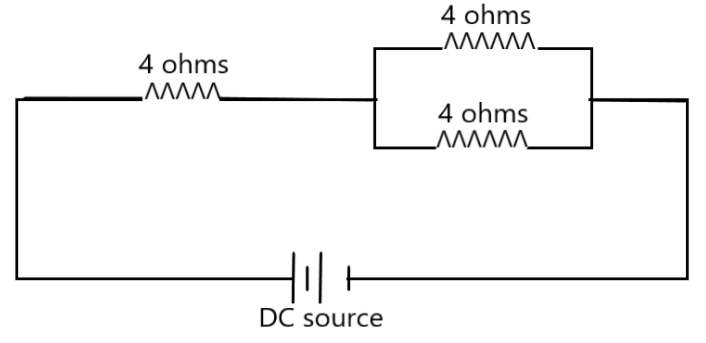
Answer
377.7k+ views
Hint: This question is based on a combination of resistors, there are two types of combination Series and parallel. A circuit is said to be connected in series when the same amount of current flows through the resistors. And A circuit is said to be connected in parallel when the voltage is the same across the resistors.
Formula Used: \[R{}_{eq} = \,R{}_1 + {R_2} + {R_{3.........}}\] (for series) and \[R{}_{eq} = \,\dfrac{1}{{{R_1}}} + \dfrac{1}{{{R_2}}} + \dfrac{1}{{{R_3}}}........\] (for parallel).
Complete step-by-step solution:
To get an equivalent resistance of \[6\Omega \], we have to use both parallel and series combinations in the circuit.
First, the two resistors are connected in parallel combination to obtain equivalent resistance of \[2\Omega \]
Then the combined resistance (of \[2\Omega \]) in series this will give total resistance equal to \[6\Omega \]
That is,
\[ R{}_{eq} = \,\dfrac{1}{4} + \dfrac{1}{4} \\
\Rightarrow \dfrac{2}{4} = \dfrac{1}{2} \\
\Rightarrow {R_{eq}} = 2\,\Omega \]
Now this equivalent resistance of \[2\Omega \] is connected in series with the third \[4\Omega \],
\[ {R_{eq}} = 2\,\Omega + 4\,\Omega \\
{R_{eq}} = 6\,\Omega \]
When we draw a diagram of this, we get,

That is, for the two resistors in parallel the resistance is given as \[2\Omega \] and this is added with the resistance of the third resistor in the series as \[6\Omega \].
Note: Always remember that in series combination equivalent resistance comes out to be more than magnitude of single component resistor and in parallel equivalent resistance comes out to be less than that of magnitude of single component resistor.
Formula Used: \[R{}_{eq} = \,R{}_1 + {R_2} + {R_{3.........}}\] (for series) and \[R{}_{eq} = \,\dfrac{1}{{{R_1}}} + \dfrac{1}{{{R_2}}} + \dfrac{1}{{{R_3}}}........\] (for parallel).
Complete step-by-step solution:
To get an equivalent resistance of \[6\Omega \], we have to use both parallel and series combinations in the circuit.
First, the two resistors are connected in parallel combination to obtain equivalent resistance of \[2\Omega \]
Then the combined resistance (of \[2\Omega \]) in series this will give total resistance equal to \[6\Omega \]
That is,
\[ R{}_{eq} = \,\dfrac{1}{4} + \dfrac{1}{4} \\
\Rightarrow \dfrac{2}{4} = \dfrac{1}{2} \\
\Rightarrow {R_{eq}} = 2\,\Omega \]
Now this equivalent resistance of \[2\Omega \] is connected in series with the third \[4\Omega \],
\[ {R_{eq}} = 2\,\Omega + 4\,\Omega \\
{R_{eq}} = 6\,\Omega \]
When we draw a diagram of this, we get,

That is, for the two resistors in parallel the resistance is given as \[2\Omega \] and this is added with the resistance of the third resistor in the series as \[6\Omega \].
Note: Always remember that in series combination equivalent resistance comes out to be more than magnitude of single component resistor and in parallel equivalent resistance comes out to be less than that of magnitude of single component resistor.
Recently Updated Pages
How many sigma and pi bonds are present in HCequiv class 11 chemistry CBSE

Mark and label the given geoinformation on the outline class 11 social science CBSE

When people say No pun intended what does that mea class 8 english CBSE

Name the states which share their boundary with Indias class 9 social science CBSE

Give an account of the Northern Plains of India class 9 social science CBSE

Change the following sentences into negative and interrogative class 10 english CBSE

Trending doubts
Fill the blanks with the suitable prepositions 1 The class 9 english CBSE

Which are the Top 10 Largest Countries of the World?

Give 10 examples for herbs , shrubs , climbers , creepers

Difference Between Plant Cell and Animal Cell

Difference between Prokaryotic cell and Eukaryotic class 11 biology CBSE

The Equation xxx + 2 is Satisfied when x is Equal to Class 10 Maths

Change the following sentences into negative and interrogative class 10 english CBSE

How do you graph the function fx 4x class 9 maths CBSE

Write a letter to the principal requesting him to grant class 10 english CBSE



